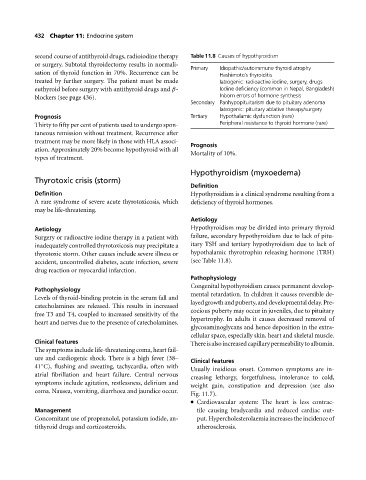Page 436 - Medicine and Surgery
P. 436
P1: FAW
BLUK007-11 BLUK007-Kendall May 25, 2005 8:5 Char Count= 0
432 Chapter 11: Endocrine system
second course of antithyroid drugs, radioiodine therapy Table 11.8 Causes of hypothyroidism
or surgery. Subtotal thyroidectomy results in normali-
Primary Idiopathic/autoimmune thyroid atrophy
sation of thyroid function in 70%. Recurrence can be Hashimoto’s thyroiditis
treated by further surgery. The patient must be made Iatrogenic: radioactive iodine, surgery, drugs
euthyroid before surgery with antithyroid drugs and β- Iodine deficiency (common in Nepal, Bangladesh)
blockers (see page 436). Inborn errors of hormone synthesis
Secondary Panhypopituitarism due to pituitary adenoma
Iatrogenic: pituitary ablative therapy/surgery
Prognosis Tertiary Hypothalamic dysfunction (rare)
Thirty to fifty per cent of patients used to undergo spon- Peripheral resistance to thyroid hormone (rare)
taneous remission without treatment. Recurrence after
treatment may be more likely in those with HLA associ-
Prognosis
ation. Approximately 20% become hypothyroid with all
Mortality of 10%.
types of treatment.
Hypothyroidism (myxoedema)
Thyrotoxic crisis (storm)
Definition
Definition Hypothyroidism is a clinical syndrome resulting from a
Arare syndrome of severe acute thyrotoxicosis, which deficiency of thyroid hormones.
may be life-threatening.
Aetiology
Aetiology Hypothyroidism may be divided into primary thyroid
Surgery or radioactive iodine therapy in a patient with failure, secondary hypothyroidism due to lack of pitu-
inadequately controlled thyrotoxicosis may precipitate a itary TSH and tertiary hypothyroidism due to lack of
thyrotoxic storm. Other causes include severe illness or hypothalamic thyrotrophin releasing hormone (TRH)
accident, uncontrolled diabetes, acute infection, severe (see Table 11.8).
drug reaction or myocardial infarction.
Pathophysiology
Congenital hypothyroidism causes permanent develop-
Pathophysiology
mental retardation. In children it causes reversible de-
Levels of thyroid-binding protein in the serum fall and
layedgrowthandpuberty,anddevelopmentaldelay.Pre-
catecholamines are released. This results in increased
cocious puberty may occur in juveniles, due to pituitary
free T3 and T4, coupled to increased sensitivity of the
hypertrophy. In adults it causes decreased removal of
heart and nerves due to the presence of catecholamines.
glycosaminoglycans and hence deposition in the extra-
cellular space, especially skin, heart and skeletal muscle.
Clinical features Thereisalsoincreasedcapillarypermeabilitytoalbumin.
The symptoms include life-threatening coma, heart fail-
ure and cardiogenic shock. There is a high fever (38–
Clinical features
41 C), flushing and sweating, tachycardia, often with
◦
Usually insidious onset. Common symptoms are in-
atrial fibrillation and heart failure. Central nervous
creasing lethargy, forgetfulness, intolerance to cold,
symptoms include agitation, restlessness, delirium and
weight gain, constipation and depression (see also
coma. Nausea, vomiting, diarrhoea and jaundice occur.
Fig. 11.7).
Cardiovascular system: The heart is less contrac-
Management tile causing bradycardia and reduced cardiac out-
Concomitant use of propranolol, potassium iodide, an- put. Hypercholesterolaemia increases the incidence of
tithyroid drugs and corticosteroids. atherosclerosis.

